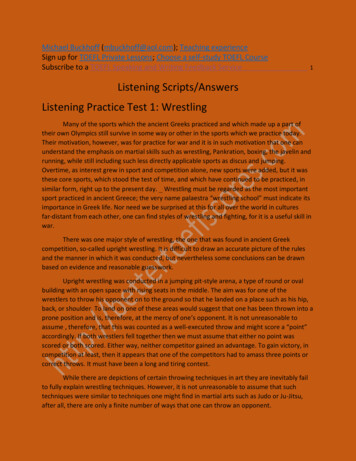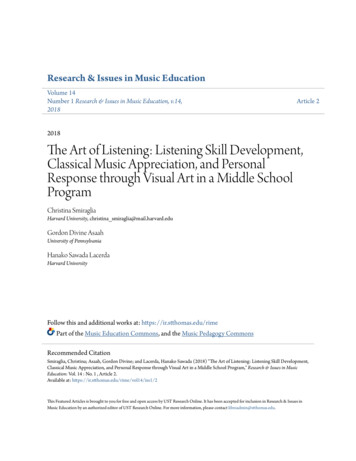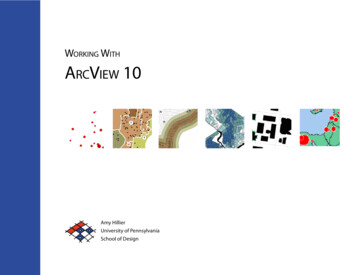
Transcription
Michael Buckhoff (mbuckhoff@aol.com); Teaching experienceSign up for TOEFL Private Lessons; Choose a self-study TOEFL CourseSubscribe to a TOEFL Speaking and Writing Feedback Service1Listening Scripts/AnswersListening Practice Test 1: WrestlingMany of the sports which the ancient Greeks practiced and which made up a part oftheir own Olympics still survive in some way or other in the sports which we practice today.Their motivation, however, was for practice for war and it is in such motivation that one canunderstand the emphasis on martial skills such as wrestling, Pankration, boxing, the javelin andrunning, while still including such less directly applicable sports as discus and jumping.Overtime, as interest grew in sport and competition alone, new sports were added, but it wasthese core sports, which stood the test of time, and which have continued to be practiced, insimilar form, right up to the present day. Wrestling must be regarded as the most importantsport practiced in ancient Greece; the very name palaestra “wrestling school” must indicate itsimportance in Greek life. Nor need we be surprised at this for all over the world in culturesfar-distant from each other, one can find styles of wrestling and fighting, for it is a useful skill inwar.There was one major style of wrestling, the one that was found in ancient Greekcompetition, so-called upright wrestling. It is difficult to draw an accurate picture of the rulesand the manner in which it was conducted, but nevertheless some conclusions can be drawnbased on evidence and reasonable guesswork.Upright wrestling was conducted in a jumping pit-style arena, a type of round or ovalbuilding with an open space with rising seats in the middle. The aim was for one of thewrestlers to throw his opponent on to the ground so that he landed on a place such as his hip,back, or shoulder. To land on one of these areas would suggest that one has been thrown into aprone position and is, therefore, at the mercy of one’s opponent. It is not unreasonable toassume , therefore, that this was counted as a well-executed throw and might score a “point”accordingly. If both wrestlers fell together then we must assume that either no point wasscored or both scored. Either way, neither competitor gained an advantage. To gain victory, incompetition at least, then it appears that one of the competitors had to amass three points orcorrect throws. It must have been a long and tiring contest.While there are depictions of certain throwing techniques in art they are inevitably failto fully explain wrestling techniques. However, it is not unreasonable to assume that suchtechniques were similar to techniques one might find in martial arts such as Judo or Ju-Jitsu,after all, there are only a finite number of ways that one can throw an opponent.
Michael Buckhoff (mbuckhoff@aol.com); Teaching experienceSign up for TOEFL Private Lessons; Choose a self-study TOEFL CourseSubscribe to a TOEFL Speaking and Writing Feedback Service2There is also another style of wrestling which did not exist on its own but which was partof the Pankration. In this style the struggle was continued on the ground till one or other of thecombatants acknowledged defeat. For the Greeks wrestling was both as science and an art andgreat importance was attached to the manner in which one conducted oneself in the ring. Tothrow one’s opponent was not enough, it had to be done stylishly and in good style.While this may have been a common held view by the Greeks this in no way detractsfrom the physicality of the sport and thus its usefulness in training the body for the exertions ofcombat.1. Palaestra Wrestling school.Jumping pit-style arena Where wrestling was conductedJu-Jitsu Martial arts2. B Upright wrestling was conducted in a jumping pit-style arena. The aim was for one of thewrestlers to throw his opponent on to the ground so that he landed on a place such as his hip,back, or shoulder.3. The correct order is as follows:3 Wrestler scores a point.4 Wrestler wins game after amassing three points or three correct throws.1 Wrestler enters a jumping pit-style arena.2 Wrestler throws his opponent onto the ground.4. C (Upright wrestling was conducted in a jumping pit-style arena, a type of round or ovalbuilding with an open space with rising seats in the middle.)
Michael Buckhoff (mbuckhoff@aol.com); Teaching experienceSign up for TOEFL Private Lessons; Choose a self-study TOEFL CourseSubscribe to a TOEFL Speaking and Writing Feedback Service35. A & D (Their motivation, however, was for practice for war and it is in such motivation thatone can understand the emphasis on martial skills such as wrestling, Pankration, boxing, thejavelin and running, while still including such less directly applicable sports as discus andjumping.)Listening Practice Test 2: WWIITo continue our discussion on women’s roles in our society, I want to talk about theeffects of World War II on women's employment in the United States Compared to Mt. Vernon,Ohio, 1938-1948. The period commencing with the Japanese attack on Pearl Harbor (December7, 1941) and ending with the completion of World War II had a great impact on women'semployment in the United States.Prior to this period employers, government and national sentiment held that there werejobs appropriate for women and those which were inappropriate because women were notcapable of fulfilling the tasks involved in such work. Propaganda reinforced these notions as thepopular image of women had them, for instance, as housewives or living glamorous lives, butalmost always dependent on men. The War years provided women of Mt. Vernon and thenation as a whole with an opportunity to break this trend.Women took this chance to prove that they were almost every bit as capable as men inthe traditionally male work sphere. There were no lasting effects on women's status in the workforce resulting from the War. In the War's aftermath, women returned to jobs they had heldtraditionally, provided they were of the working class.At the same time, many women who had not worked prior to the War returned to theirhomes and house-work. Mt. Vernon was much like many of the major war industries citiessuch as Detroit and San Francisco, although there were some key differences. In population sizeit was small. Its economy at the time was predominantly agricultural although there were threemajor industrial plants - Cooper-Bessemer (a producer of diesel engines), Mt. Vernon Bridgeand Steel (produced Landing Ship Tanks) and Shellmar (produced protective capes and gasmasks for soldiers). Factories such as these are what made Mt. Vernon similar to the major warindustries cities.Likewise, making Mt. Vernon comparable to the rest of the nation was the role womenplayed in such industrial work by filling in for men who left to fight. To recruit women into the
Michael Buckhoff (mbuckhoff@aol.com); Teaching experienceSign up for TOEFL Private Lessons; Choose a self-study TOEFL CourseSubscribe to a TOEFL Speaking and Writing Feedback Service4labor force, propaganda in magazines, advertising, radio programming and films was used forthis was the most efficient method of encouraging women to take a war job.Oral history provided much information about the status of women workers before,during and after the War in Mt. Vernon. Interviews with women who lived in Mt. Vernon duringthe period answered questions concerning womens' work status. Questions were asked aboutentire work histories which showed how many working class women took higher payingindustrial jobs during the War after having received lower wages in other work sectors. Therewere also questions about domestic lives because several of the women never worked and onegoal was to find out why they had not.The end of the War and changes it brought to Mt. Vernon's female work force wasanother issue probed. How did women feel about relinquishing their jobs to returning soldiers?Another aim was to learn more about how effective propaganda was. Did it have any effect atall, or was it more a subconcious matter that they could not answer (which was often the case).1. The correct order is as follows:3 Women proved that they were almost every bit as capable as men in the traditionallymale work sphere.4 Women relinquished their jobs to returning soldiers.1 Propaganda reinforced these notions as the popular image of women had them, forinstance, as housewives or living glamorous lives, but almost always dependent on men.2 The Japanese attack on Pearl Harbor (December 7, 1941)2. B (It is learned that propaganda reinforced these notions as the popular image of womenhad them, for instance, as housewives or living glamorous lives, but almost always dependenton men. Therefore, answer B is the correct answer.)3. C
Michael Buckhoff (mbuckhoff@aol.com); Teaching experienceSign up for TOEFL Private Lessons; Choose a self-study TOEFL CourseSubscribe to a TOEFL Speaking and Writing Feedback Service54. A & D (Answers A and D are mentioned as two effects of women status in the workforceafter the war.)5. Propaganda in magazines Used to recruit women to take a war job.Mt. Vernon Mostly agricultural.Oral history Provided much information about the status of women workers before, duringand after the War.Listening Practice Test Three: LanguagesWe don’t ask ourselves where languages come from because they just seem to be there:French in France, English in England, Chinese in China, Japanese in Japan, and so forth. Yet if wego back only a few thousand years, none of these languages were spoken in their respectivecountries and indeed none of these languages existed anywhere in the world. Where did theyall come from?In some cases, the answer is clear and well-known. We know that Spanish is simply alater version of the Latin language that was spoken in Rome two thousand years ago. Latinspread with the Roman conquest of Europe and, following the breakup of the Roman Empire,the regional dialects of Latin gradually evolved into the modern Romance languages: Sardinian,Rumanian, Italian, French, Catalan, Spanish, and Portuguese. A language family, such as theRomance family, is a group of languages that have all evolved from a single earlier language, inthis case Latin.But while the Romance family illustrates well the concept of a language family, it is alsohighly unusual in that the ancestral language - Latin - was a written language that has left uscopious records. The usual situation is that the ancestral language was not a written languageand the only evidence we have are its modern descendants. Yet even without written records,it is not difficult to distinguish language families. Similarities among certain languages in theword for "hand" allow us to readily identify not only the Romance family (Spanish, Italian,Rumanian), but also the Slavic family (Russian, Polish, Serbo-Croatian) and the Germanic family(English, Danish, German). There are, however, no written records of the languages ancestral tothe Germanic or Slavic languages, so these two languages - which must have existed no lessthan Latin - are called Proto-Germanic and Proto-Slavic, respectively.
Michael Buckhoff (mbuckhoff@aol.com); Teaching experienceSign up for TOEFL Private Lessons; Choose a self-study TOEFL CourseSubscribe to a TOEFL Speaking and Writing Feedback Service6If we examine words other than "hand," we find many additional instances where eachof these three families is characterized by different-looking roots, just as in the case of "hand."But we also find, from time to time, roots that seem to be shared by these three families; thatis, the same root is found in all three families. What is the meaning of such roots? In fact,similarities among language families such as Romance, Germanic, and Slavic have the samemeaning as similarities among languages in any one family - they imply that these three familiesare branches of an even more ancient family. In other words, a language that existed longbefore Latin, Proto-Germanic, or Proto-Slavic first differentiated into these three languages andthen they, in turn, diversified into the modern languages of each family. This larger, moreancient family is known as the Indo-European family and it includes almost all Europeanlanguages (but not Basque, Hungarian, or Finnish), and many other languages of Iran,Afghanistan, Pakistan, and India.The Language Families of the World chart shows that the Indo-European family has, infact, thirteen branches; in addition to Romance, Germanic, and Slavic; there are also Baltic,Celtic, Iranian, Indic, Tocharian, Anatolian, and three single languages that are by themselvesseparate branches of the family: Armenian, Greek, and Albanian.The thirteen branches of IndoEuropean are connected to one another by numerous words and grammatical endings. Let'stake a look at some examples of this now.The Exploratorium. "The Evolution of Languages."1999. nguage article3.html (August 10,2001)1. Romance family: A group of languages that have all evolved from a single earlier languageIndo-European family: A larger, more ancient family which includes almost all EuropeanlanguagesProto-Germanic and Proto-Slavic: Ancestral to the Germanic or Slavic languages2. A (Basque is not mentioned as being part of the Indo-European language family.)3. The correct order is as follows:1. Latin language was spoken in Rome two thousand years ago.
Michael Buckhoff (mbuckhoff@aol.com); Teaching experienceSign up for TOEFL Private Lessons; Choose a self-study TOEFL CourseSubscribe to a TOEFL Speaking and Writing Feedback Service72. Latin spread with the Roman conquest of Europe.3. The Roman Empire collapsed.4. The regional dialects of Latin gradually evolved into the modern Romance languages.4. A (We know that Spanish is simply a later version of the Latin language that was spoken inRome two thousand years ago.).5. C and D (Japanese and Chinese are not mentioned as romance languages.)Listening Practice Test Four
Michael Buckhoff (mbuckhoff@aol.com); Teaching experienceSign up for TOEFL Private Lessons; Choose a self-study TOEFL CourseSubscribe to a TOEFL Speaking and Writing Feedback Service8The platypus is one of the two animals in the order Monotremata. It is the only memberof the mammal family Ornithorhynchidae. Platypus is from the Greek platys meaning “broad”and “pous” meaning foot, referring to the animal's webbed foot.The platypus has several reptilian characteristics which include using the same openingfor reproduction and eliminating waste products, the ability to lay eggs, cervical ribs, and localascorbic acid synthesis in the kidney. Even though the platypus has these reptile characteristics,it is overall much more mammalian than reptilian. This unique animal has a lifespan of 10 to 15years.The platypus is about the size of a household cat. The male platypus's body is about 50 60 centimeters long and the female is about 40 - 50 centimeters long. An adult male platypusweighs about 2 kilograms and a female platypus weighs about .9 kilograms. The platypus has athick covering of waterproof hair all over its body except for the feet and bill. The outer hair is adark brown with yellowish hair on its underside. There are about 800 hairs per squaremillimeter. This is denser than the fur of the river otter or polar bear. The platypus has twolayers of hair. The top or longer layer is a shiny guard fur with a woolly short fur undercoat. Thethermal qualities of the fur allow the platypus to withstand cold temperatures.The platypus's sensitive, pliable bill is a blue-gray, blackish color with the two nostrilholes near the tip. The location of the nostrils allows the platypus to breath while the rest ofthe body remains under the water surface. The lower bill is smaller than the upper bill. Thelower bill is held in place by two elongated dentary bones which is found in all mammals. Thebill contains an electro-receptor system which has approximately 850,000 electrical and tactilereceptors. When the platypus goes underwater or drives for food, it closes its ears, eyes, andnostrils. Its electro-receptor system detects the electric currents created by the muscle activityof small prey and may even help the platypus detect the electric field created when water flowsover prey hidden under rocks, mud, and small debris. As the platypus gathers food in its mouth,it moves the food to its cheek pouches. When it returns to the surface, it pushes the food fromits cheek pouches up to its mouth. It then grinds it with its grinding pads.The ear openings or grooves are on either side of the platypus's head. The platypus doesnot have external ears. These openings are closed when diving or swimming under water. Outof the water, these ear openings are very sensitive to sounds. The small, beady eyes are verysensitive to movement. Cone cells have been found in the retina. This indicates the possibilityof color vision for the platypus. Its eyes are well placed for scanning river banks.
Michael Buckhoff (mbuckhoff@aol.com); Teaching experienceSign up for TOEFL Private Lessons; Choose a self-study TOEFL CourseSubscribe to a TOEFL Speaking and Writing Feedback ServiceThe platypus has four legs which extend horizontally from its body. This arrangementmakes it walk on land with a shuffle like a lizard. The front feet have large webs of skin whichhelp to propel the platypus through the water.1. Bill: Contains an electro-receptor system which has approximately 850,000 electrical andtactile receptorsEar openings: Located on either side of the platypus's headLegs: Extend horizontally from its body2. C (According to the lecture, picture “C” best fits the description of a platypus.)3. D (The platypus's sensitive, pliable bill is a blue-gray, blackish color with the two nostrilholes near the tip. The location of the nostrils allows the platypus to breath while the rest ofthe body remains under the water surface. The lower bill is smaller than the upper bill.)4. C (It is learned that the platypus lives near and swims in rivers.)5. A and C (The platypus has several reptilian characteristics which include using the sameopening for reproduction and eliminating waste products, the ability to lay eggs, cervical ribs,and local ascorbic acid synthesis in the kidney.)Listening Practice Test 5: Meteorites9
Michael Buckhoff (mbuckhoff@aol.com); Teaching experienceSign up for TOEFL Private Lessons; Choose a self-study TOEFL CourseSubscribe to a TOEFL Speaking and Writing Feedback Service10Meteors are small particles of matter in the solar system that are only directlyobservable when they fall into the earth’s atmosphere. A meteorite is a meteor that reachesthe surface of the earth without being vaporized. Meteorites are particularly valuable geologicspecimens because they represent samples of planetary bodies (mostly asteroids) which wehave not yet obtained through either manned or unmanned space missions. Neither is it likelythat samples of these bodies will be available by any other means than fortuitous falls for atleast a generation. Thus, as a scientific resource, meteorites provide us with some of our firstglimpses of the diverse array of planetary material scattered throughout the inner solar system.The oldest meteorite specimens are remnants of the very first geologic processes tooccur in our solar system 4.6 billion years ago. (The origin of the solar system should not beconfused with the origin of the universe, commonly known as the Big Bang, which occurred atleast 9 billion years ago and possibly as long ago as 20 billion years.) Our solar system formedwhen a cloud of interstellar dust and gas collapsed. Because the interstellar cloud had beenslowly spinning, the result was a nearly flat rotating disk which we refer to as the solar nebula.Much of the dust and gas in the disk moved to the center of the nebula where it fed a growingprotostar which eventually became our sun.The dust and gas remaining in the nebula was incorporated into primitive planetarymaterial. Initially, nebular dust stuck together (or accreted) to form small, loosely-bounddustballs. In some regions of the solar nebula these dustballs encountered violent, hightemperature events and were melted, forming molten silicate and metal droplets (like lava).Henry Clifton Sorby, a geologist of the 1800's and one of the first to examine these dropletswith a microscope, described them as having once looked like fiery rain. Because the hightemperature events were brief, the molten droplets cooled quickly in the nebula and formedmillimeter-sized spheres of rock called chondrules. Meteorites containing these objects arecalled chondrites.Sometimes the temperatures rose so high in the solar nebula that dust began toevaporate, leaving behind refractory residues. At other times, the temperatures became so lowthat new dust condensed from the nebular gas (like snow from the air). Over time, chondrules,evaporative residues, and condensates collided with each other and accreted to form nebularsediments and eventually larger bodies called planetesimals (a few to several tens of kilometersin diameter). Our most primitive meteorite specimens are samples of these complex, yetprimitive, mixtures of nebular (pre-planetary) material. In many cases these meteorites are soprimitive they contain traces of interstellar dust which survived thermal processing in the solarnebula.
Michael Buckhoff (mbuckhoff@aol.com); Teaching experienceSign up for TOEFL Private Lessons; Choose a self-study TOEFL CourseSubscribe to a TOEFL Speaking and Writing Feedback Service11The small planetary bodies from which primitive meteorites come formed throughout alarge portion of the inner solar system. Within these vast distances material was apparentlydistributed unevenly and affected by different amounts of thermal processing. Thus, meteoriticparent bodies produced in different regions of the solar nebula had slightly different chemicaland structural properties. The three principal groups of primitive chondrites representing thesevariations are the carbonaceous chondrites, enstatite chondrites, and unequilibrated ordinarychondrites.1. Molten silicate and metal droplets: Similar to lavaMillimeter-sized spheres of rock: ChondrulesSmall particles of matter in the solar system: Meteors2. B and D (The oldest meteorite specimens are remnants of the very first geologic processesto occur in our solar system 4.6 billion years ago. Our solar system formed when a cloud ofinterstellar dust and gas collapsed.)3. The order is as follows:1. A cloud of interstellar dust and gas collapsed2. A flat rotating disk called a solar nebula was formed3. Much of the dust and gas moved to the center of the nebula4. The Sun was formed4. A (A meteorite is a meteor that reaches the surface of the earth without being vaporized.)5. B & D (Stalagmite and icicle are not mentioned as being primitive chondrites.)Listening Practice Test 6
Michael Buckhoff (mbuckhoff@aol.com); Teaching experienceSign up for TOEFL Private Lessons; Choose a self-study TOEFL CourseSubscribe to a TOEFL Speaking and Writing Feedback Service12Picture the most violent of all tornadoes: A violent whirling column of air with speeds of100 to 300 miles per hour, a funnel which extends downward from a cumulonimbus cloud,almost always seen as rapidly rotating; a slender, a funnel shaped cloud which usually destroyseverything in its path. More than anyone else in the history of meteorology, Tetsuya Theodore(Ted) Fujita increased our knowledge of severe storms, especially tornadoes. Here is a brief listof what Tom Grazulis, Director of the Tornado Project, considers to be some of his most notableachievements: Professor Fujita was brought to the United States in the early 1950's by HoraceByers of the University of Chicago. He proceeded to change the course and the speed of severestorm research like no one else in this century. Shortly after his arrival, he began analyzingsingle thunderstorms the way larger systems had been studied for decades. He saw them asindividual weather systems, which he called mesoscale systems.Fujita introduced the concept of tornado families, which are made up of individualtornadoes, each with a unique path, but spawned by the same thunderstorm. Prior to this, longdamage paths were usually considered to be made by a single tornado. Through analysis of thephotographs of the Fargo, North Dakota storm, he introduced concepts of thunderstormarchitecture and terms like "wall cloud" and "tail cloud". He saw in these storms things that wetake for granted today. But it took a genius to see them for the first time. In the 1960's, hisanalysis of the Palm Sunday outbreak of 1965 again changed the course of how we view atornado outbreak. For the first time, he mapped the entire outbreak in terms of tornadofamilies. From the thousands of aerial photographs of Palm Sunday damage, he concluded thatthere was indeed something special about certain tornadoes.that they must contain morethan one vortex.While multiple vortex tornadoes are well known today, he was the first to identify theirexistence based on damage patterns. In the 1970's, he again revolutionized tornado climatologyby giving us a system that linked damage and wind speed. Previous to this, all tornadoes werecounted as equals. Today, the term "F5" is used casually by the general public, and in movies.Without Ted, one can only guess whether there would be any system at all. The Super Outbreakof 1974 was the pinnacle of his analysis of a tornado outbreak. For many of the 148 tornadoes,he was able to map the entire path in Fujita Scale-intensity contours. Confusing damagepatterns from this outbreak would later allow him to identify a new kind of windstorm. Hewould also mentor a group of students who today are among the leaders in many areas ofmeteorology. His ability to simpify concepts of severe storms was a great aid in publiceducation, and allowed others to better educate the public. After 25 years we still use his ideasand terminology.
Michael Buckhoff (mbuckhoff@aol.com); Teaching experienceSign up for TOEFL Private Lessons; Choose a self-study TOEFL CourseSubscribe to a TOEFL Speaking and Writing Feedback Service13Later in the 1970's, he turned his focus to weather-related aircraft disasters. From this,and his studies of confusing damage patterns in the Super Outbreak, he identified two otherphenomena that we take for granted, the downburst and the microburst. Prior to this,meteorologists had been confused by a bewildering array of gusty winds in and aroundthunderstorms. By the 1980's, the downburst and microburst were being studied as a uniquephenomena generated by things such as an intrusion of dry air. At long last, we had a way todistinguish tornado damage from damage of non-tornadic winds. Then as you know he passedaway in 1998, leaving a vast amount of useful research for meteorologists.1. Tetsuya Theodore Fujita Introduced the concept of tornado familiesTom Grazulis Director of the Tornado ProjectHorace Byers From the University of Chicago2. D (A tornado is described as a violent whirling column of air with speeds of 100 to 300 milesper hour, a funnel which extends downward from a cumulonimbus cloud, almost always seenas rapidly rotating; a slender, a funnel shaped cloud which usually detroys everything in itspath.)3. The correct order is as follows:1. The downburst and microburst were being studied as a unique phenomenagenerated by things such as an intrusion of dry air. (1980's)2. Fujita revolutionized tornado climatology by giving us a system that linked damageand wind speed. (1970's)3. Analysis of the Palm Sunday outbreak was done by Fujita. (1965)4. Fujita came to the United States. (Early 1950's)4. A & B (It is learned that Fujita was a mentor to students, which means he was a counselor orguru to them.)5. A & C (By the 1980's, the downburst and microburst were being studied as a uniquephenomena generated by things such as an intrusion of dry air. At long last, we had a way to
Michael Buckhoff (mbuckhoff@aol.com); Teaching experienceSign up for TOEFL Private Lessons; Choose a self-study TOEFL CourseSubscribe to a TOEFL Speaking and Writing Feedback Service14distinguish tornado damage from damage of non-tornadic winds. From this, it is learned thatthe downburst and the microburst are examples of non-tornadic winds.)Listening Practice Test 7More than thirty-six years after he made history as the first American to orbit the Earth,Senator John H. Glenn, Jr. will return to space as part of a multi-national crew with the launchof Space Shuttle Discovery in late October. The flight, designated STS-95, will involve more thaneighty scientific experiments investigating mysteries that span the realm from the inneruniverse of the human body to studies of our own Sun and its solar activity.Back on February 20, 1962, when Glenn flew in his Friendship 7 Mercury capsule, thelargest mystery facing the young NASA space program was whether humans could even survivein the hostile environment of space. In the 121 space missions since Glenn’s flight during theMercury, Gemini, Apollo, Skylab, and Shuttle programs, more than 200 Americans have flown –and thrived – in space. Glenn, who inspired many current astronauts to pursue space flight as acareer, continues to inspire people of all generations as he prepares for a return to space.The wealth of scientific data accumulated during these space flights validate apparentsimilarities between the effects of space flight and aging. Glenn will be a test subject for specificinvestigations which mimic the effect of aging, including loss of muscle mass and bone density;disrupted sleep patterns; a depressed immune system; and loss of balance.Scientific endeavors on the STS-95 mission are not limited to furthering anunderstanding of the human body, but also will expand our understanding of the closest
Listening Practice Test 1: Wrestling . Sign up for TOEFL Private Lessons; Choose a self-study TOEFL Course Subscribe to a TOEFL Speaking and Writing Feedback Service 2 There is also another style of wrestling which did not exist on its own but which was part of the Pankration. In this style










